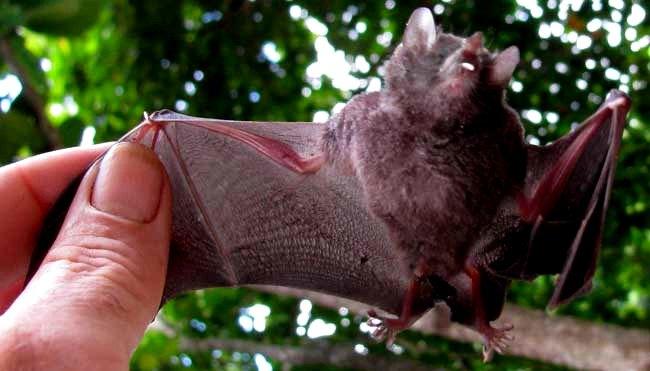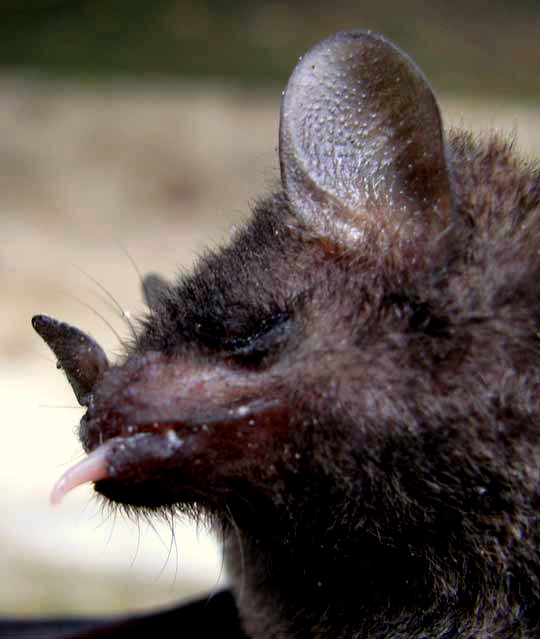Excerpts from Jim Conrad's
Naturalist Newsletter
from the May 2, 2010 Newsletter issued from Hacienda Chichen Resort beside Chichén Itzá Ruins, central Yucatán, MÉXICO; limestone bedrock, elevation ~39m (~128ft), ~N20.676°, ~W88.569°
A LONG-TONGUED BAT
A brown bat hung from a rafter in a room adjoining the old church, so I took the flash-assisted picture shown below:

Best I can tell, that bat really is sticking its tongue out at me. Also, best I can tell, it's the Argentine Brown Bat*. There's no field guide to Yucatec bats, however, and there are similar species. Internet pictures of Argentine Brown Bats look like this one, plus that species is known to be common from Mexico to Argentina, and often roosts in buildings, so that's a good guess.
Also, the tragus -- that little triangular flap of flesh visible inside the base of each ear -- is the right size and shape for that species, and that's an important feature.

from the August 8, 2010 Newsletter issued from Hacienda Chichen Resort beside Chichén Itzá Ruins, central Yucatán, MÉXICO; limestone bedrock, elevation ~39m (~128ft), ~N20.676°, ~W88.569°
LONG-TONGUED BAT
Once again during my weekly banana-buying jaunt into Pisté I came upon a bat lying motionless on the ground. You might recall the big Jamaican Fruit Bat we found like that and reported on in last year's December 6th Newsletter. That piece is still at www.backyardnature.net/yucatan/fruitbat.htm.
That bat was special not only because of its size but because it was a leaf-nosed bat -- bore a fleshy, leaflike appendage above its nostrils, clearly seen in the photo at the above page.
This week's bat was much smaller, dark gray instead of the Jamaican Fruit Bat's rusty color, but it also bore a leafy flange above its nostrils. You can see it dangling from my fingers (skyward is at the picture's left) at the top of this page.
A close-up of the head with its slender tongue sticking out (the bat turned out to be still alive) is below:

For all I know this could be an immature Jamaican Fruit Bat, but my best guess is that it's the Common Long-tongued Bat, GLOSSOPHAGA SORICINA.
I came to that name rather tenuously. In the Google Books presentation of Fiona Reid's 2009 book A Field Guide to The Mammals of Central America and Southeast Mexico, I looked at all the leaf-nose bat distribution maps available and found only the Common Long-tongued Bat in our area, though Google left out a few pages so you'll buy the complete book. There I also read that Common Long-tongued Bats have long, slender tongues, and are the most commonly encountered nectar-feeding bats in Central America. Also it looks like other Common Long-tongued Bats shown on the Internet. Therefore, without examining teeth and other obscure details, "Common Long-tongued Bat" is a decent bet.
Common Long-tongued Bats, Fiona Reid reports, eat moths and fruits in the wet season and nectar and pollen in the dry season. They roost in small to large groups in caves, tunnels, culverts, hollow trees and buildings, usually not in complete darkness. Individuals hang singly or in clusters.
I have no idea why this bat appeared to be almost dead. Maybe he was just drunk from sipping too much fermented sap. Whatever his condition, I left him in the angle formed where a Sabal Palmetto frond attached to its trunk, and wished him the best.